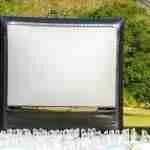Are you looking to invest in a projector for a home theater and don’t know where to start? It’s important to understand not only what options are available to you on the market but also how projectors work in the first place in order to make your vision a reality.
It can be a tough choice when you don’t know where to start your research or what you should be looking for to meet your needs. A great place to begin is with the basics, so we’ve put together this guide to learn all you need to know about projectors and how they work.
The Mechanics of a Projector
So, how does a projector work? The short and sweet explanation is that to project an image onto a screen or wall, you need a light source and something to place in front of that source. The light will filter through or around that object, and the shadow will be displayed on the wall or surface behind.
Shadow puppets are one of the first examples we experience this mechanism. It’s a little more complex when you move onto projectors that you can use to watch movies and TV, but the premise is the same. The moving images or film are displayed in front of a light source, and that image is then reflected onto the projector screen in front of the light. Advances in projector technology have allowed for projectors to become brighter, more vivid, and extremely clear, allowing for the growing popularity of this type of display for home use.
Types of Projection
There are two types of projection used to display images for people to enjoy. The first is front projection, which you would experience in a movie theater or at the drive-in. This means that the light source and the image to be projected is in front of the screen that it will be observed on. Have you ever turned around at the cinema and seen the movie projector pointing towards the large screen?
There is also back projection, which you see when you watch TV at home. The light source and images are projected from behind the screen you are looking at, and you observe the projection in front of the screen. There is no light source behind you with this projection source, as it is projected from the back of the viewing screen. Inside televisions, there is a complex mechanism that helps project the screen properly. While modern TVs now contain LED (light-emitting diode) or LCDs (liquid crystal display), a basic understanding of the two types of projection is still simply front or back projection.
What Projectors are Available on the Market?
Wondering what different projectors are currently available on the market? There are three basic types you should be aware of.
LCD Projectors
Many modern projectors are LCD-based, which means that they use one very bright light source to shine through a small LCD screen inside the projector. This image then passes through a lens inside the projector housing, which results in an extremely magnified version of the original image on the projection screen. This allows the image quality of modern projectors to be extremely bright and clear and lighter, more portable, and easier to install in a variety of locations in a home, including outside. If this sounds like it will meet your needs, the FANGOR 1080P HD Projector is a popular LCD projector for home use.
DLP Projectors

A new type of digital projector is now on the market that uses microscopic mirrors to create the projected image. DLP stands for digital light processing, and it uses bright lighting that is projected using tiny mirrors. This manipulates the way the light shines and hits the display surface creating the image you see as the viewer. A microchip called a digital micromirror device, or DMD, is used to control the movements of the mirrors. This microchip contains about 2 million tiny mirrors in a grid pattern, with each of those mirrors being so small that it is thinner than a human hair.
Each tiny mirror allows each chip to control a point of light about the size of a pixel on a traditional TV. The light that bounces off these mirrors is then filtered through a color wheel that contains red, blue, and yellow, which allows the light to be transformed into any color before being bounced to display on the viewing screen. This way, the picture quality is crystal-clear by using the targeted light. For some helpful tips on what to look for in a DLP projector, check out our article on what to look for in a DLP projector.
Laser Projectors

The third type of home theater projector uses lasers to create the final image that appears on the screen. They can be used to create a sharp, brightly colored image at a very short range. You can get a clearly displayed image of up to 10-15 feet even while the projector unit is only 3.5 feet from the screen! The laser can be a single laser that is used to create all the colors, or three lasers in the primary colors (red, blue, and yellow) that combine to make any needed colors on the display. These lasers are usually diode lasers, like the kind you see in a laser printer, and use the same DMD mirror divide to control and reflect the light onto the desired display surface. If you’re looking to set up in a smaller space, a laser projector could be the best match for you. If so, this Epson Home Cinema Projector is an excellent choice.
Final Thoughts
Now that you are a master of projectors and their inner workings, you can begin the task of narrowing down which unit will be the best to add to your home viewing events. We hope you found this article useful as a starting point, and you can search through all the newest makes and models with confidence.
If you’d like to learn more about projector throw and ideal placement for any of the units mentioned above, check out this handy guide.




